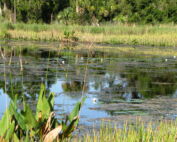Executive Summary
Filter Marsh Functional Assessment Method: Development of a functional assessment method to evaluate the water quality benefits of wetland restoration and designed freshwater and brackish water ecosystems used for water quality treatment.
This project will develop a functional assessment method to evaluate the water quality benefits of wetland restoration and designed freshwater and brackish water ecosystems used for water quality treatment. This method would be utilized for evaluating and crediting water quality improvements in Basin Management Action Plans (BMAPs) to address non-attainment of Total Maximum Daily Loads (TMDLs). The methodology would be developed in coordination with an interagency “A-Team”. Team members will be brought to an agreed-upon common baseline of knowledge about functional assessment methods. The new method will be developed focusing on biological and physical surrogates for water quality measurements, and then be tested. After calibration, the new method will be retested to assure that the surrogates are applicable. EPA and state, local and private sector practitioners will be invited to test the new method. The new method will then be presented for formal acceptance by the state as one tool in the BMAP arsenal.
Document Resources
- Lee County Water Quality Capital Improvement Projects
- Bayley, Suzanne, and Howard T. Odum. “Simulation of interrelations of the Everglades’ marsh, peat, fire, water and phosphorus.” Ecological Modeling 2 (1976): 169-188.http://www.swflregionalvision.com/content/WQFAM/Bayley_Odum_1976.pdf
- Capone, L. T., F. T. Izuno, A. B. Bottcher, c. A. Sanchez, F. J. Coale, and D. B. Jones. “Nitrogen concentrations in agricultural drainage water in south Florida.” Transactions of the American Society of Agricultural Engineers (American Society of Agricultural Engineers) 38, no. 4 (1995): 1089-1098.
- Charlotte Harbor Environmental Center, Inc. Water Quality Maps. 2006-2008.
- Gayle, Timothy Lawrence. Systems models for understanding eutrophication in Lake Okeechobee. Master’s Thesis, Gainesville: University of Florida, 1975.
- Howard-Williams, Clive. “Cycling and retention of nitrogen and phosphorus in wetlands: a theoretical and applied perspective.” Freshwater Biology 15 (1985): 391-431.
- Karuna-Muni, Anura, P.E., Ronland Ottolini, P.E. and Eric Livingston Ten Mile Canal Filter Marsh Project in Lee County.
- Knight, Robert L., and William F. Coggins. Record of estuarine and salt marsh metabolism at Crystal River, Florida, 1977-1981. Final Summary Report to Florida Power Corporation, Environmental Engineering Sciences, University of Florida, Gainesville: University of Florida, 1982.
- Mitsch, William Joseph. Systems analysis of nutrient disposal in cypress wetlands and lake ecosystems in Florida. PhD Dissertation, Gainesville: University of Florida, 1975.
- Morrill, John B. 208 Program Water Quality Study of the Lemon Bay Complex Study Area. Executive Summary, Environmental Studies Program, New College, Ft. Myers: Southwest Florida Regional Planning Council, 1977.
- Odum, H. T., and F. G. Nordlie. “Water quality models for understanding potential eutrophication in Lake Okeechobee, Florida.” 1976.
- Professional Service Industries, Inc. The Effectiveness of Vegetated Floating Mats in Sequestering Nutrients in a Structurally Controlled Waterbody. Research Report, Ft. Myers: Lee County Department of Natural Resources, 2010.
- Reiss, Kelly Chinners, Jason Evans, and Mark T. Brown. Summary of the available literature on nutrient concentrations and hydrology for Florida isolated wetlands. Howard T. Odum Center for Wetlands, University of Florida, Tallahassee: Florida Department of Environmental Protection, 2009.
- Schwartz, Larry Neal. Nutrient, carbon, and water dynamics of a titi shrub ecosystem in Apalachicola, Florida. PhD Dissertation, Gainesville: University of Florida, 1989.
- Sell, Jr., Maurice George. Modeling the response of mangrove ecosystems to herbicide spraying, hurricanes, nutrient enrichment and economic development. PhD Dissertation, Gainesville: University of Florida, 1977.
- Stone, James H., Jr., Leonard M. Bahr, and Jr., John W. Day. “Effects of canals on freshwater marshes in coastal Louisiana and implications for management.” In Freshwater Wetlands: Ecological Processes and Management Potential, edited by Ralph E. Good, Dennis F. Whigham and Robert L. Simpson, 299-320. New York: Academic Press, 1978.
- Turner, R. Eugene. “Beneath the salt marsh canopy: loss of soil strength with increasing nutrient loads.” Estuaries and Coasts (Coastal and Estuarine Research Federation) 34 (2011): 1084-1093.
- US Environmental Protection Agency. National Recommended Water Quality Criteria. August 19, 2009.
- USEPA. “Water Quality Criteria for Nitrogen and Phosphorus Pollution.” Water Quality Criteria Home. December 2000.
- Atlanta Regional Commission. “Georgia Stormwater Management Manual.” Vol. 2. Atlanta, Georgia: Atlanta Regional Commission, August 2001.
- Booth, Derek B., David Hartley, and Rhett Jackson. “Forest cover, impervious-surface area, and the mitigation of stromwater impacts.” Journal of the American Water Resources Association 38, no. 3 (June 2002): 835-845.
- Tilley, David R., and Mark T. Brown. “Wetland networks for stormwater management in subtropical urban watersheds.” Ecological Engineering (Ecological Engineering) 10 (1998): 131-158.
- Best, G. Ronnie, Larry N. Schwartz, and Charlotte P. Wolfe. Low-energy wastewater recycling through wetland ecosystems. Final Summary Progress Report 1985-1987, Center for Wetlands, University of Florida, Gainesville: University of Florida, 1989.
- Boylan Environmental Consultants, Inc. Boylan Memo 060903 Response to Bruce rev6-9-03
- Boyt, Florence Lorene. “A mixed harwood swamp as an alternative to tertiary wastewater treatment.” Gainesville, Florida: University of Florida, 1976.
- Brodie, Gregory A. “Selection and evaluation of sites for constructed wastewater treatment wetlands.” Edited by Donald A. Hammer. Proceedings from the First International Conference on Constructed Wetlands for Wastewater Treatment held in Chattanooga, Tennessee on June 13-17, 1988. Chelsea, Michigan: Lewis Publishers, 1989. 307-317.
- Center for Environmental Research Information. Design Manual: Constructed wetlands and aquatic plant systems for municipal wasterwater treatment. Design Manual, Office of Research and Development, U.S. Environmental Protection Agency, Cincinnati: U.S. Environmental Protection Agency, 1988.
- DeBusk, T. A., P. S. Burgoon, and K. R. Reddy. “Secondary treatment of domestic wastewater using floating and emergent macrophytes.” Edited by Donald A. Hammer. Proceedings from the First International Conference on Constructed Wetlands for Wastewater Treatment held in Chattanooga, Tennessee on June 13-17, 1988. Chelsea, Michigan: Lewis Publishers, 1989. 525-529.
- Ewel, Katherine Carter, and H. T. Odum. Cypress swamps for nutrient removal and wastewater recycling. Summary of work done by a research group, Gainesville: University of Florida, 1978.
- Hicks, Delbert B., and Q. J. Stober. “Monitoring of constructed wetlands for wastewater.” Edited by Donald A. Hammer. Proceedings from the First International Conference on Constructed Wetlands for Wastewater Treatment held in Chattanooga, Tennessee on June 13-17, 1988. Chelsea, Michigan: Lewis Publishers, 1989. 447-455.
- Kadlec, R. H., and D. L. Hey. “Constructed wetlands for river water quality improvement.” Wat. Sci. Tech. (IAWQ) 29, no. 4 (1994): 159-168.
- Kadlec, Robert H. “Hydrologic factors in wetland water treatment.” Edited by Donald A. Hammer. Proceedings from the First International Conference on Constructed Wetlands for Wastewater Treatment held in Chattanooga, Tennessee on June 13-17, 1988. Chelsea, Michigan: Lewis Publishers, 1989. 21-40.
- Kadlec, Robert H., and Scott Wallace. Treatment Wetlands. 2nd edition. Boca Raton, Florida: CRC Press, 2009. (book)
- Lee, Chang-gyun, Tim D. Fletcher, and Guangzhi Sun. “Nitrogen removal in constructed wetland systems.” Engineering in Life Sciences 9, no. 1 (2009): 11-22.
- Lee, Erik R., Saied Mostaghimi, and Theresa M. Wynn. “A model to enhance wetland design and optimize nonpoint source pollution control.” Journal of the American Water Resources Association (American Water Resources Association) 38, no. 1 (February 2002): 17-32.
- Megic, Brian J., Tim Madhanagopal, Gabe Delneky, and Wayne A. Mather. “A First for Florida: Lake Augmentation Integrates Water Reuse and Water Supply.” PB Network. no. 64. Post Buckley, December 2006.
- National Risk Management Research Laboratory. Manual: Constructed wetlands treatment of municipal wastewaters. Manual, Office of Research and Development, U.S. Environmental Protection Agency, Cincinnati: U.S. Environmental Protection Agency, 1999.
- Owens, L. Patrice, C. Ross Hinkle, and G. Ronnie Best. “Low-energy wastewater recycling through wetland ecosystems: copper and zinc in wetland microcosms.” Edited by R. R. Sharitz and J. W. Gibbons. Freshwater Wetlands and Wildlife (U.S. DOE Office of Scientific and Technical Information), no. 61 (1989): 1227-1235.
- Wadzuk, Bridget M., Matthew Rea, Gregg Woodruff, Kelly Flynn, and Robert G. Traver. “Water-quality performance of a constructed stormwater wetland for all flow conditions.” Journal of the American Water Resources Association (American Water Resources Association) 46, no. 2 (April 2010): 385-394.
- Wang, Huaguo, James W. Jawitz, John R. White, Christopher J. Martinez, and Mark D. Sees. “Rejuvenating the largest municipal treatement wetland in Florida.” Ecological Engineering 26 (2006): 132-146.
- Zoltek, Jr., John, Suzanne E. Bayley, Albert J. Hermann, Louis R. Tortora, and Thomas J. Dolan. Removal of nutrients from treated municipal wastewater by freshwater marshes. Final Report to the City of Clermont, Florida, Gainesville: University of Florida, 1979.
- Allen, Hollis H., Gary J. Pierce, and Rex Van Wormer. “Considerations and techniques for vegetation establishment in constructed wetlands.” Edited by Donald A. Hammer. Proceedings from the First International Conference on Constructed Wetlands for Wastewater Treatment held in Chattanooga, Tennessee on June 13-17, 1988. Chelsea, Michigan: Lewis Publishers, 1989. 405-415.
- Borer, Robert Ernest. “Influence of soil flooding and nutrient load on growth of selected wetland plants.” Gainesville, Florida: University of Florida, 1994.
- Boyt, F. L., S. E. Bayley, and Jr., J. Zoltek. “Removal of nutrients from treated municipal wastewater by wetland vegetation.” Journal (Water Pollution Control Federation) (Water Environment Federation) 49, no. 5 (May 1977): 789-799.
- Gebhardt, Danielle M. Uptake abilities and hydrologic regimes of selected wetland and aquatic plants. Master’s Thesis, Gainesville: University of Florida, 1998.
- Godshalk, Gordon L., and Robert G. Wetzel. “Decomposition in the littoral zone of lakes.” Edited by Ralph E. Good, Dennis F. Whigham and Robert L. Simpson. Proceedings of the Symposium Freshwater Marshes: Present Status, Future Needs, held in February 1977 at Rutgers University. New York: Academic Press, 1978. 131-143.
- Guntenspergen, G. R., F. Stearns, and J. A. Kadlec. “Wetland Vegetation.” Edited by Donald A. Hammer. Proceedings from the First International Conference on Constructed Wetlands for Wastewater Treatment held in Chattanooga, Tennessee on June 13-17, 1988. Chelsea, Michigan: Lewis Publishers, 1989. 73-88.
- Michaud, Susan Copeland, and Curtis J. Richardson. “Relative radial oxygen loss in five wetland plants.” Edited by Donald A. Hammer. Proceedings from the First International Conference on Constructed Wetlands for Wastewater Treatment held in Chattanooga, Tennessee on June 13-17, 1988. Chelsea, Michigan: Lewis Publishers, 1989. 501-507.
- Odum, William E., and Mary A. Heywood. “Decomposition of intertidal freshwater marsh plants.” Edited by Ralph E. Good, Dennis F. Whigham and Robert L. Simpson. Proceedings of the Symposium Freshwater Marshes: Present Status, Future Needs. New York: Academic Press, 1978. 89-97.
- Reddy, K. R., and T. A. DeBusk. “State-of-the-art utilization of aquatic plants in water pollution control.” Wat. Sci. Tech (IAWPRC) 19, no. 10 (1987): 61-79.
- Vymazal, Jan. “Use of perphyton for nutrient removal from waters.” Edited by Donald A. Hammer. Proceedings from the First International Conference on Constructed Wetlands for Wastewater Treatment held in Chattanooga, Tennessee on June 13-17, 1988. Chelsea, Michigan: Lewis Publishers, 1989. 558-564.
- Beever III, J.W., W. Gray, L. Beever, D. Cobb 2011. A Watershed Analysis of Permitted Coastal Wetland Impacts and Mitigation Methods within the Charlotte Harbor National Estuary Program Study Area. 391 pp.
- Brinson, Mark M. A Hydrogeomorphic Classification for Wetlands. Technical Report, Vicksburg: U.S. Army Engineer Waterways Experiment Station, 1993.
- Brown, Mark T. Evaluating created wetlands through comparisons with natural wetlands. Technical Report, Center for Wetlands, University of Florida, Corvallis: USEPA Environmental Research Laboratory, 1991.
- CH2M-Hill. Treatment wetland habitat and wildlife use assessment. Executive Summary, Office of Water, U.S. Environmental Protection Agency, U.S. Environmental Protection Agency, 1999.
- Clairain, Jr., Ellis J. “Chapter 1: Introduction and Overview of the Hydrogeomorphic Approach.” In Hydrogeomorphic Approach to Assessing Wetland Functions: Guidelines for Developing Regional Guidebooks. Vicksburg, MS: U.S. Army Engineer Research and Development Center, 2002.
- Environmental Laboratory. Corps of Engineers Wetlands Delineation Manual. Technical Report, Vicksburg: U.S. Army Engineer Waterways Experiment Station, 1987.
- Estevez, Ernest D. “Review and Assessment of Biotic Variables and Analytical Methods Used in Estuarine Inflow Studies.” Estuaries, 2002: 1291-1303.
- Fennessy, M. Siobhan, Amy D. Jacobs, and Mary E. Kentula “Review of Rapid Methods For Assessing Wetland Condition.” U.S. Environmental Protection Agency, 2004.
- Florida State Legislature. F.A.C. 62-302.530, Criteria for Surface Water Quality Classifications. Tallahassee, April 2, 2008.
- Lane, Charles Raymond. Biological indicators of wetland condition for isolated depressional herbaceous wetlands in Florida. PhD Dissertation, Gainesville: University of Florida, 2003.
- Miller, Raymond E., and Boyd E. Gunsalus. Wetland Rapid Assessment Procedure (WRAP). Technical Publication, Natural Resource Management Division, Regulation Department, West Palm Beach: South Florida Water Management District, 1999.
- Noble, Chris V., Rhonda Evans, Marti McGuire, Katherine Trott, Mary Davis, and Jr., Ellis J. Clairain. A Regional Guidebook for Applying the Hydrogeomorphic Approach to Assessing Wetland Functions of Flats Wetlands in the Everglades. U.S. Army Engineer Research and Development Center, U.S. Army Corps of Engineers, Vicksburg: U.S. Army Corps of Engineers, 2002.
- Noble, Chris V., Rhonda Evans, McGuire Marti, Katherine Trott, Mary Davis, and Jr., Ellis J. Clairain. A Regional Guidebook for Applying the Hydrogeomorphic Approach to Assessing Wetland Functions of Depressional Wetlands in Peninsular Florida. Final Report, Ecosystem Management and Restoration Research Program, US Army Corps of Engineers, Washington, DC: US Army Corps of Engineers, 2004.
- Reiss, Kelly Chinners. Developing biological indicators for isolated forested wetlands in Florida. PhD Dissertation, Gainesville: University of Florida, 2004.
- Rheinhardt, Richard D., Martha Craig Rheinhardt, and Mark M. Brinson. A Regional Guidebook for Applying the Hydrogeomorphic Approach to Assessing Wetland Functions of Wet Pine Flats on Mineral Soils in the Atlantic and Gulf Coastal Plains. U.S. Army Engineer Research and Development Center, U.S. Army Corps of Engineers, Vicksburg: U.S. Army Engineer Research and Development Center, 2002.
- Shafer, Deborah J., et al. Regional Guidebook for Applying the Hydrogeomorphic Approach to Assessing Wetland Functions of Northwest Gulf of Mexico Tidal Fringe Wetlands. Final Report, Wetlands Research Program, US Army Corps of Engineers, Washington, DC: US Army Corps of Engineers, 2002.
- Smith, R. Daniel. “Chapter 3: Developing a Reference Wetland System.” In Hydrogeomorphic Approach to Assessing Wetland Functions: Guidelines for Developing Regional Guidebooks. Vicksburg, MS: U.S. Army Engineer Research and Development Center, 2001.
- Smith, R. Daniel, and James S. Wakeley. “Chapter 4: Developing Assessment Models.” In Hydrogeomorphic Approach to Assessing Wetland Functions: Guidelines for Developing Regional Guidebooks. Vicksburg, MS: U.S. Army Engineer Research and Development Center, 2001.
- Wakeley, James S., and R. Daniel Smith. “Chapter 7: Verifying, Field Testing, and Validating Assessment Models.” In Hydrogeomorphic Approach to Assessing Wetland Functions: Guidelines for Developing Regional Guidebooks. Vicksburg, MS: US Army Engineer Research and Development Center, 2001.
- Brown, Mark T., and Joseph M. Schaefer. An evaluation of the applicability of upland buffers for the wetlands of the Wekiva Basin. Final, Center for Wetlands, University of Florida, Gainesville: University of Florida, 1987.
- Evans, David L. Aquatic macroinvertebrate communities of constructed and natural freswater marshes in central Florida. PhD Dissertation, Gainesville: University of Florida, 1996.
- Fernandes, Carlos A. Replacement of gizzard shad (Dorosoma cepedianum) by blue tilapia (Tilapia aurea) as a potential biomanipulation agent in Florida eutrophic lakes. PhD Dissertation, Gainesville: University of Florida, 1994.
- Johnson Engineering. Effectiveness of Best Management Practices in Southwest Florida. Research Report, Ft. Myers: Lee County Department of Natural Resources, 2009.
RECENT PROJECTS
COVID Recovery & Resiliency
rharp2023-08-15T14:35:56+00:00August 15th, 2023|
City of Clewiston Waterfront Master Plan
rharp2021-09-08T16:00:25+00:00September 8th, 2021|
Agriculture Projects
rharp2022-01-10T16:50:27+00:00September 25th, 2020|
Resiliency & Climate Change Projects
rharp2019-08-07T17:21:22+00:00July 26th, 2019|
Ecosystem Service Projects
rharp2020-09-25T18:07:38+00:00February 15th, 2019|







